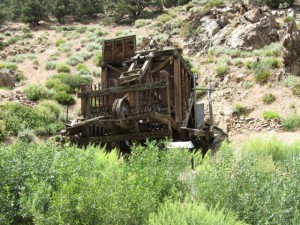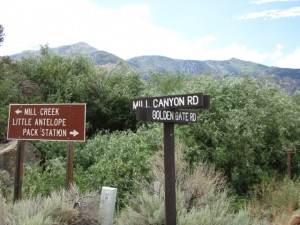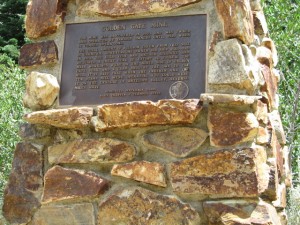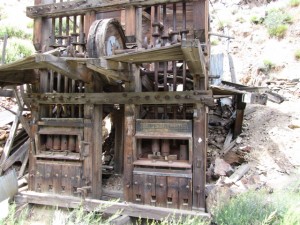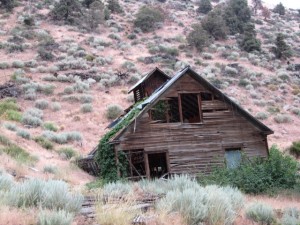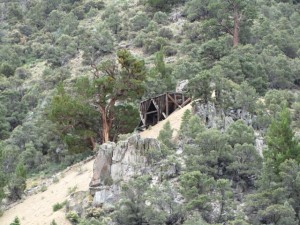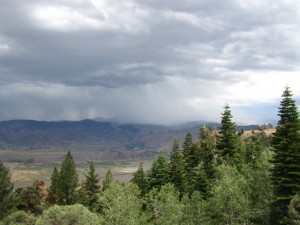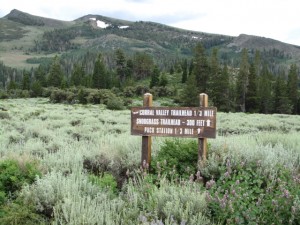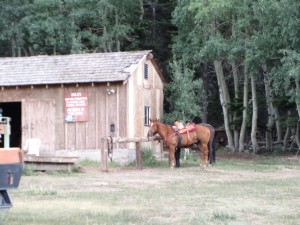On a whim, we drove over to 395 and discovered an interesting abandoned Gold mine in the Eastern Sierras just a bit south of the junction of US 395 and Highway 89 near Coleville.
I had been looking over some maps, looking for possible access points to the Eastern Sierras when I noticed one that looked promising.
Just a couple miles south of Coleville, there’s a dirt road that takes off in a Westerly direction from US 395. The road is called Mill Canyon Road. It, as well as the rest of the roadways I describe in this article, were well graded dirt roads with only a couple sections of washboard and a couple places where shallow water was washing over the roadway. I can’t guarantee what it will be like when you visit, but I would have been comfortable taking a normal 2 wheel drive vehicle everywhere we went.
From the junction with 395, we take Mill Canyon Road about a third of a mile east to a well signed junction with Golden Gate Road. Here, we are going to the right on Golden Gate Road and leave Mill Canyon Road for another day of exploration.
After another 2.7 miles, we were surprised to find the old abandoned stamp mill for the Golden Gate mine. Until we reached it, there had been no indication that we were on our way to this historically significant location.
According to the historical marker located across the road from the stamp mill, the Golden Gate Mine was opened in 1903 and operated until 1939.
There is a short trail up to the stamp mill where you can get a close look. There is also a display next to the mill showing what it looked like when it was new. It also explains how the mill, and several nearby buildings have been damaged or destroyed by periodic avalanches. The mill is located near the canyon floor at nearly 6500 feet so it’s easy to understand how avalanches could be a problem.
The mill was run by water though it is difficult now to see the source. I did not see evidence of a water wheel but suspect that it was one of the many features destroyed by the elements and time, To the left of the mill there did appear to be what perhaps was once a ditch that may have been part of a flume and ditch system used to bring water from further up the canyon to run the mill. The stamp mill consisted of ten steel stamps, running off a cam system, each about six to eight inches in diameter. These stamps would have been lifted up and then let fall on the ore below to crush it into fine powder. This had to make a horrible racket when it was running!
A little before we reached the mill we passed a couple of buildings, one completely destroyed and one barely standing. These were apparently the bunk house and chow hall for the worker at the mine, According to the information at the mill, these buildings have been severely damaged by avalanches as mentioned earlier.
I believe the one standing may have been the bunk house but I don’t know for sure.
About 4o feet further up the road, you can see the old mine itself up the hill to the left (South). According to topo maps there is a trail that can take you there but we didn’t go looking for it as thunder storms were on their way.
While it is likely that the mine workers took horses, wagons, and perhaps even trucks up to the mine, the ore itself was carried down to the mill via a tram system. Nearby the mill there appears to be what perhaps once was one end of this tram system. Also, further up the road I noticed fencing that appeared to be using old steel cable rather than barbed wire. I suspect that this cable may have been scavenged from the mine after it was abandoned but I don’t have proof of this.
Once we pass the mine Golden Gate Road turns North East and for a while we travel along, but not too near, a steep slope which yields spectacular views across Little Antelope Valley about 2000 feet below. On the day we were out here, there were thunder storms blowing through which made the scene all the more dramatic.
After a while, Golden Gate Road swings to the left as we pass a couple dirt tracks off to the right that look interesting (for another day).
About 2.8 miles from the stamp mill, or 6.2 miles from 395, we come to Rodriguez Flat. Here we have to choose whether to go left to the Corral Valley Trail Head or right to the Snodgrass Trailhead and the Pack Station. This time, our choice was to go right.
Several trails that take off from the Corral Valley trailhead are described in the latest edition of the book Sierra North: Backcountry Trips in Californias Sierra Nevada (which you can purchase here!). Take a look at page 256.
Since we decided to go right at the Rodriguez Flat junction we’re headed for the Snodgrass Creek trailhead and the Pack Station. In about a third of a mile, 6.6 miles from 395, we reach the trailhead. There are wilderness permits at an information kiosk there. The trail follows Snodgrass Creek into the Carson Iceberg Wilderness Area and then intersets the Silver Creek trail that goes up and down stream along Silver King Creek.
After visiting the Snodgrass Creek trailhead, we get back on Golden Gate Road and head South to where the road ends a few hundred feet further on at the Little Antelope Pack Station. This was the second surprise of the day!
The pack station apparently provides all kinds of pack and guide services like hunting trips, fishing trips, backpacking supply dropoff or backpacker dropoff and pickup, etc. Pretty cool! You can learn more about them on their website.
That was it for our little road trip. Just after we turned around at the pack station, the thunderstorm hit and we started getting intermittent bursts of hail and buckets of rain. The road stayed good all the way out which we were glad for.
You could take this road on a mountain bike if you don’t mind the elevation gain. However, I wouldn’t recommend it. While the road is well graded, it can be very dusty and it seems to be fairly well used. So, on a mountain bike you may find yourself dodging vehicles and eating more than your share of dust.
This was a fun drive with good road conditions, beautiful views, some history, and some interesting possibilities for future hikes, backpacks and fishing trips.  I hope you get the chance to experience it for yourself!
joe
